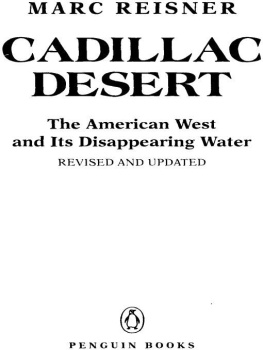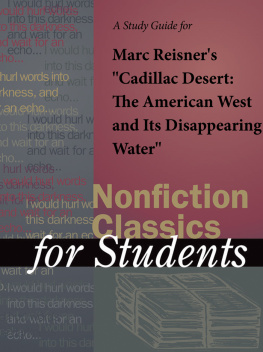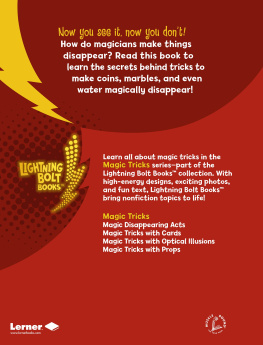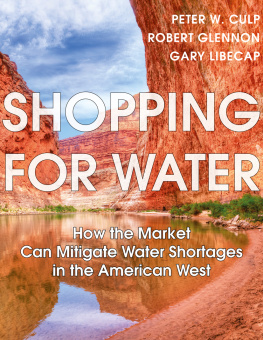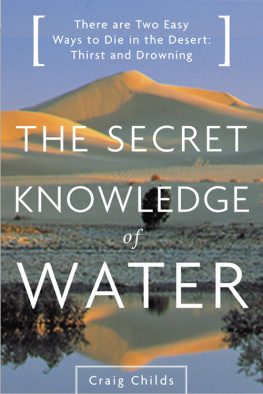
Cadillac Desert
MARC REISNER
Penguin Group USA
Table of Contents
Praise forCadillac Desert
The definitive work on the Wests water crisis
NewsweekIntelligent, provocative, and compulsively readable
Chicago Sun-TimesThe scale of this book is as staggering as that of Hoover Dam. Beautifully written and meticulously researched, it spans our century-long effort to moisten the arid West.... Anyone thinking of moving west of the hundredth meridian should read this book before they call their real estate agent.
St. Louis Post-DispatchA masterful account ... among the best-read, most influential environmental books published by an American since Silent
SpringSan Francisco ExaminerA highly partisan, wonderfully readable portrayal of the damming, diverting and dirtying of western rivers
Washington Post Book WorldOne of the triumphs of the year
London ObserverA revealing, absorbing, often amusing and alarming report on where billions of [taxpayers] dollars have goneand where a lot more are going ... [Reisner] has put the story together in trenchant form.
The New York Times Book ReviewWell-written history and analysis, thoroughly researched and abundantly clear in its message
Los Angeles Times Book ReviewPugnacious ... Well-documented ... A compelling, cautionary tale, one that should be required reading for the federal bureaucracy
Chicago TribuneSometimes startling, always perceptive ... Written in a style that pops and sparkles like a fresh mountain stream
SmithsonianCadillac Desert is a book that no American concerned about the nations future can afford to miss.... A fascinating, stubbornly logical, expert analysis of the problems the American West has had in trying to capture and control enough water to supply its agriculture and growing population
The Grand Rapids PressThoughtful and sprightly ... Reisners book deserves to be widely read by political leaders, as well as environmentalists and just about anyone interested in water policies.... After reading Cadillac Desert, it is hard to be indifferent about the importance of water.
Christian Science MonitorFascinating ... Reisner has an uncanny gift for mingling narrative with quotes, historical references, and even suspense.
Oakland TribuneA magnificent piece of investigative journalism ... Reisner documents how the unholy rivalry between the Bureau of Reclamation and the Army Corps of Engineers led to the construction of dozens of wasteful, useless dams in the past sixty years.
Palo Alto Times TribuneAn incredible story ... This timely and important book should be required reading for all citizens.
Publishers WeeklyPENGUIN BOOKS
CADILLAC DESERT
Marc Reisner (1948-2000) was, in Jim Harrisons words, in the upper echelon of those defending the environment with conscience, intelligence and energy. Born in St. Paul, Minnesota, Reisner was a 1970 graduate of Earlham College in Indiana. A staff writer for the Natural Resources Defense Council from 1972 to 1979, Reisner received an Alicia Patterson Journalism Fellowship in 1979 to investigate water resources in the West. His book
Cadillac Desert: The American West and Its Disappearing Water (1986) was acclaimed as the definitive work on the Wests water crisis
(Newsweek) and went on to be nominated for a National Book Critics Circle Award. Reisner was also author of
Game Wars: The Undercover Pursuit of Wildlife Poachers (1991) and the posthumously published
A Dangerous Place: Californias Unsettling Fate.OZYMANDIAS
I met a traveller from an antique landWho said: Two vast and trunkless legs of stoneStand in the desert ... Near them, on the sand,Half sunk, a shattered visage lies, whose frown,And wrinkled lip, and sneer of cold command,Tell that its sculptor well those passions readWhich yet survive, stamped on these lifeless things,The hand that mocked them, and the heart that fed:And on the pedestal these words appear:My name is Ozymandias, king of kings:Look on my works, ye Mighty, and despair!Nothing beside remains. Round the decayOf that colossal wreck, boundless and bareThe lone and level sands stretch far away.
PERCY BYSSHE SHELLEY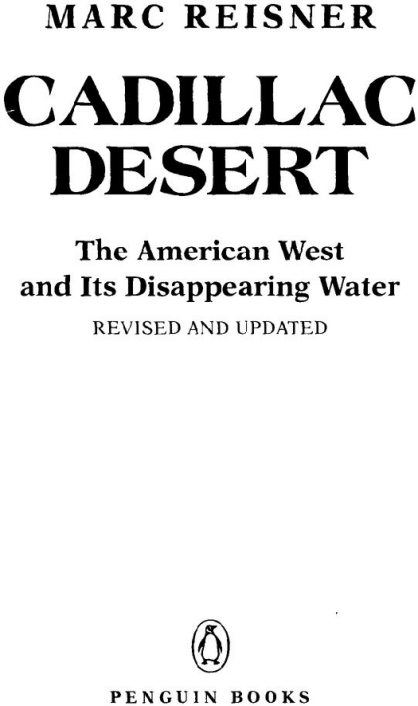
For Konrad and Else Reisner
PENGUIN BOOKS
Published by the Penguin Group
Penguin Group (USA) Inc., 375 Hudson Street, New York, New York 10014, U.S.A.
Penguin Group (Canada), 90 Eglinton Avenue East, Suite 700, Toronto, Ontario,
Canada M4P 2Y3 (a division of Pearson Penguin Canada Inc.)
Penguin Books Ltd, 80 Strand, London WC2R ORL, England
Penguin Ireland. 25 St Stephens Green, Dublin 2, Ireland
(a division of Penguin Books Ltd)
Penguin Group (Australia), 250 Camberwell Road, Camberwell, Victoria 3124,
Australia (a division of Pearson Australia Group Pty Ltd)
Penguin Books india Pvt Ltd., If Community Centre,
Panchsheel Park, New Delhi - 110 017, India
Penguin Group (NZ), cnr Airborne and Rosedale Roads, Albany,
Auckland 1310, New Zealand (a division of Pearson New Zealand Ltd)
Penguin Books (South Africa) (Pty) Ltd, 24 Sturdee Avenue,
Rosebank, Johannesburg 2196, South Africa
Penguin Books Ltd, Registered Offices:
80 Strand, London WC2R ORL, England
First published in the United States of America by
Viking Penguin Inc. 1986
Published in Penguin Books 1987
This revised and updated edition published in Penguin Books 1993
Copyright Marc Reisner, 1986, 1993
Maps copyright Viking Penguin Inc., 1986
All rights reserved
Grateful acknowledgment is made for permission to reprint an excerpt from
Talking Columbia, words and music by Woody Guthrie. TRO Copyright
1961 and 1963 Ludlow Music, Inc., New York, N.Y. Used by permission.
LIBRARY OF CONGRESS CATALOGING IN PUBLICATION DATA
Reisner, Marc
Cadillac desert
Reprint. Originally published, New York, N.Y., U.S.A.
Viking, 1986.
Bibliography.
Includes index.
1. IrrigationGovernment policyWest (U.S.)History.
2. Water resources developmentGovernment policyWest
(U.S.)History. 3. Corruption (in politics)West (U.S.)
History. I. Title.
[HD1739.A17R45 1987] 333.9100978 87.7602
eISBN : 978-1-440-66718-3
The scanning, uploading and distribution of this book via the Internet or
via any other means without the permission of the publisher is illegal and
punishable by law. Please purchase only authorized electronic editions,
and do not participate in or encourage electronic piracy of copyrighted materials.
Your support of the authors rights is appreciated.
http://us.penguingroup.com
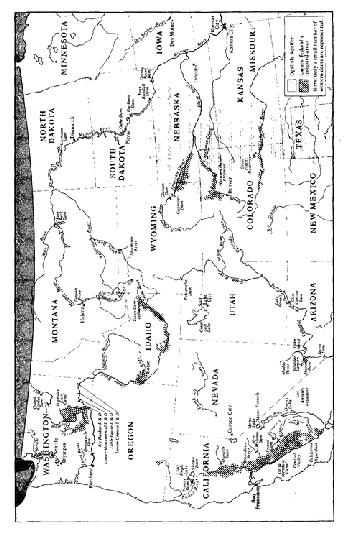
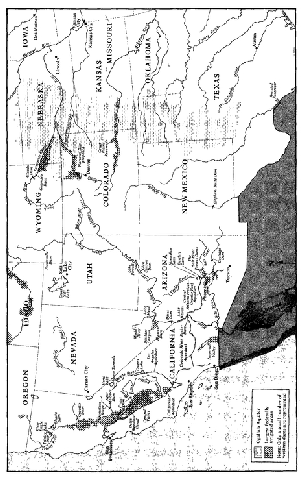
INTRODUCTION
A Semidesert with a Desert Heart
One late November night in 1980 I was flying over the state of Utah on my way back to California. I had an aisle seat, and since I believe that anyone who flies in an airplane and doesnt spend most of his time looking out the window wastes his money, I walked back to the rear door of the airplane and stood for a long time at the doors tiny aperture, squinting out at Utah.Two days earlier, a fierce early blizzard had gone through the Rocky Mountain states. In its wake, the air was pellucid. The frozen fire of a winters moon poured cold light on the desert below. Six inches away from the tip of my nose the temperature was, according to the pilot, minus sixty-five, and seven miles below it was four above zero. But here we were, two hundred highly inventive creatures safe and comfortable inside a fat winged cylinder racing toward the Great Basin of North America, dozing, drinking, chattering, oblivious to the frigid emptiness outside.Emptiness. There was nothing down there on the earthno towns, no light, no signs of civilization at all. Barren mountains rose duskily from the desert floor; isolated mesas and buttes broke the wind-haunted distance. You couldnt see much in the moonlight, but obviously there were no forests, no pastures, no lakes, no rivers; there was no fruited plain. I counted the minutes between clusters of lights. Six, eight, nine, elevengoing nine miles a minute, that was a lot of uninhabited distance in a crowded century, a lot of emptiness amid a civilization whose success was achieved on the pretension that natural obstacles do not exist.Then the landscape heaved upward. We were crossing a high, thin cordillera of mountains, their tops already covered with snow. The Wasatch Range. As suddenly as the mountains appeared, they fell away, and a vast gridiron of lights appeared out of nowhere. It was clustered thickly under the aircraft and trailed off toward the south, erupting in ganglionic clots that winked and shimmered in the night. Salt Lake City, Orem, Draper, Provo: we were over most of the population of Utah.That thin avenue of civilization pressed against the Wasatches, intimidated by a fierce desert on three sides, was a poignant sight. More startling than its existence was the fact that it had been there only 134 years, since Brigham Young led his band of social outcasts to the old bed of a drying desert sea and proclaimed, This is the place! This was the place? Someone in that first group must have felt that Young had become unhinged by two thousand horribly arduous miles. Nonetheless, within hours of ending their ordeal, the Mormons were digging shovels into the earth beside the streams draining the Wasatch Range, leading canals into the surrounding desert which they would convert to fields that would nourish them. Without realizing it, they were laying the foundation of the most ambitious desert civilization the world has seen. In the New World, Indians had dabbled with irrigation, and the Spanish had improved their techniques, but the Mormons attacked the desert full-bore, flooded it, subverted its dreadful indifferencemoralized ituntil they had made a Mesopotamia in America between the valleys of the Green River and the middle Snake. Fifty-six years after the first earth was turned beside City Creek, the Mormons had six million acres under full or partial irrigation in several states. In that year1902the United States government launched its own irrigation program, based on Mormon experience, guided by Mormon laws, run largely by Mormons. The agency responsible for it, the U.S. Bureau of Reclamation, would build the highest and largest dams in the world on rivers few believed could be controlledthe Colorado, the Sacramento, the Columbia, the lower Snakeand run aqueducts for hundreds of miles across deserts and over mountains and through the Continental Divide in order to irrigate more millions of acres and provide water and power to a population equal to that of Italy. Thanks to irrigation, thanks to the Bureauan agency few people knowstates such as California, Arizona, and Idaho became populous and wealthy; millions settled in regions where nature, left alone, would have countenanced thousands at best; great valleys and hemispherical basins metamorphosed from desert blond to semitropic green.On the other hand, what has it all amounted to?Stare for a while at a LANDSAT photograph of the West, and you will see the answer: not all that much. Most of the West is still untrammeled, unirrigated, depopulate in the extreme. Modern Utah, where large-scale irrigation has been going on longer than anywhere else, has 3 percent of its land area under cultivation. California has twelve hundred major dams, the two biggest irrigation projects on earth, and more irrigated acreage than any other state, but its irrigated acreage is not much larger than Vermont. Except for the population centers of the Pacific Coast and the occasional desert metropolisEl Paso, Albuquerque, Tucson, Denveryou can drive a thousand miles in the West and encounter fewer towns than you would crossing New Hampshire. Westerners call what they have established out here a civilization, but it would be more accurate to call it a beachhead. And if history is any guide, the odds that we can sustain it would have to be regarded as low. Only one desert civilization, out of dozens that grew up in antiquity, has survived uninterrupted into modern times. And Egypts approach to irrigation was fundamentally different from all the rest.If you begin at the Pacific rim and move inland, you will find large cities, many towns, and prosperous-looking farms until you cross the Sierra Nevada and the Cascades, which block the seasonal weather fronts moving in from the Pacific and wring out their moisture in snows and drenching rains. On the east side of the Sierra-Cascade crest, moisture drops immediatelyfrom as much as 150 inches of precipitation on the western slope to as little as four inches on the easternand it doesnt increase much, except at higher elevations, until you have crossed the hundredth meridian, which bisects the Dakotas and Nebraska and Kansas down to Abilene, Texas, and divides the country into its two most significant halvesthe one receiving at least twenty inches of precipitation a year, the other generally receiving less. Any place with less than twenty inches of rainfall is hostile terrain to a farmer depending solely on the sky, and a place that receives seven inches or lessas Phoenix, El Paso, and Reno dois arguably no place to inhabit at all. Everything depends on the manipulation of wateron capturing it behind dams, storing it, and rerouting it in concrete rivers over distances of hundreds of miles. Were it not for a century and a half of messianic effort toward that end, the West as we know it would not exist.The word messianic is not used casually. Confronted by the desert, the first thing Americans want to do is change it. People say that they love the desert, but few of them love it enough to live there. I mean in the real desert, not in a make-believe city like Phoenix with exotic palms and golf-course lawns and a five-hundred-foot fountain and an artificial surf. Most people love the desert by driving through it in air-conditioned cars, experiencing its grandeur. That may be some kind of experience, but it is living in a fools paradise. To
Next page




